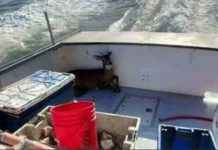
Feb. 28 (UPI) — Scientists have recovered plastic pollution from the guts of species that make their homes in the planet’s deepest ocean trenches.
Previous studies have identified plastic bits in the stomachs and intestines of hundreds of marine species, but the latest findings suggest there are no longer any plastic-free marine ecosystems.
Researchers collected a variety of crustaceans from the five locations within the Pacific’s deepest trenches, the Marianas and Hebrides. The animals were recovered using a deep-sea “lander.” The contraptions were lowered nearly 20,000 feet and left to perform monitoring and sampling tasks.
Scientists found the plastic remains of clothes, containers and packaging inside the guts of the collected crustaceans. Other marine animals may periodically mistake a piece of plastic for food, but species living at the bottom of the ocean — where food is scarce — have evolved to eat anything and everything.
The landers collected 90 crustaceans. Some 50 percent of the the animals retrieved from the floor of the Hebrides Trench had ingested plastic. The guts of all of the crustacean specimens recovered from the Marianas revealed plastic bits.
“This study has shown that manmade microfibers are culminating and accumulating in an ecosystem inhabited by species we poorly understand, cannot observe experimentally and have failed to obtain baseline data for prior to contamination,” Alan Jamieson, marine scientist at Newcastle University, said in a news release. “These observations are the deepest possible record of microplastic occurrence and ingestion, indicating it is highly likely there are no marine ecosystems left that are not impacted by anthropogenic debris.”
Jamieson and his colleagues published their latest research this week in the journal Royal Society Open Science.
Scientists are currently working on technologies to clean plastic pollution from the surface of the ocean, but as plastic debris is broken down into smaller pieces and sinks deeper into the ocean, it becomes a permanent part of the environment.
“If you contaminate a river, it can be flushed clean. If you contaminate a coastline, it can be diluted by the tides,” Jamieson said. “But, in the deepest point of the oceans, it just sits there. It can’t flush and there are no animals going in and out of those trenches.”






